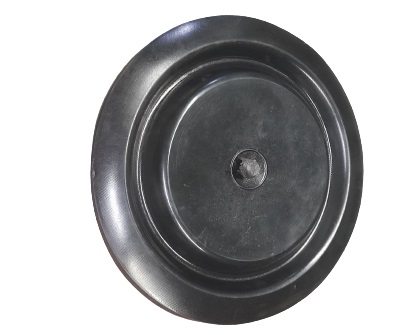
Rubber Diaphragms
With an experience of many years in the rubber industry we have successfully attained a strong foothold over the domestic and international markets offering a wide assortment of Rubber Diaphragms.
Rubber diaphragms are flexible, elastomeric components that are used in a wide range of applications to create a seal or barrier, as well as to transmit pressure or motion between two or more components. They are typically made from various types of rubber or elastomeric materials, such as natural rubber, synthetic rubber (like Nitrile, Neoprene, or EPDM), silicone rubber, or other specialized elastomers, depending on the specific application's requirements. Here are some key features and applications of rubber diaphragms:
Rubber Diaphragms Pump
Diaphragms pumps use a flexible membrane to separate the fluid being pumped from the pump mechanism. The movement of the membrane creates suction, which draws fluid into the pump, and then the release of the membrane creates pressure, which pushes the fluid out of the pump.
Types of Rubber Diaphragms Valve
There are several types of diaphragms valves, including PRV diaphragms, control valve actuators diaphragms, straight through KB type diaphragms, metal-bonded control valve diaphragms, rubber pads, spare diaphragms, and valve diaphragms.
PRV diaphragms
PRV diaphragms are used in pressure relief valves and are designed to release pressure in the event of an overpressure situation.
Control valve actuators diaphragms
Control valve actuators diaphragms are used to control the flow of fluid through a valve. They are typically used in applications where precise control of fluid flow is required.
Straight through KB type diaphragms
Straight through KB type diaphragms are used in applications where fluid must pass through the valve in a straight line. They are often used in piping systems where space is limited.
Metal-bonded control valve diaphragms
Metal-bonded control valve diaphragms are made from a range of materials, including stainless steel and brass, and are used in applications that require high durability.
Rubber pads
Rubber pads are a type of diaphragms that are used to control fluid flow in industrial applications.
Spare diaphragms
Spare diaphragms are diaphragms that can be replaced when they become worn or damaged.
Valve diaphragms
Valve diaphragms are used to control fluid flow in valves, helping to maintain the pressure and flow rate of fluids in a system.
In conclusion, rubber diaphragms play a critical role in a wide range of industrial applications, from pumps and valves to mechanical systems. Whether you need diaphragms pumps, valves, or spare parts, be sure to order high-quality rubber diaphragms from a reputable supplier today!
Key Features:
Flexibility: Rubber diaphragms are highly flexible, allowing them to deform and move with changes in pressure, motion, or shape. This flexibility makes them suitable for various dynamic applications.
Sealing: Rubber diaphragms are commonly used to create a seal between two components, preventing the passage of gases or liquids. They are often found in valves, pumps, and actuators.
Pressure Transmission: Diaphragms are used to transmit pressure changes from one side of the diaphragm to the other, which is essential in various applications like pressure switches and sensors.
Dampening and Isolation: Rubber diaphragms can be used to dampen vibrations and isolate components from mechanical shocks and vibrations.
Chemical and Environmental Resistance: The choice of rubber material can be tailored to the specific environment or fluid being sealed. Different rubber compounds offer resistance to chemicals, temperature extremes, and environmental conditions.
Biocompatibility: In some applications, such as medical devices and pharmaceutical equipment, rubber diaphragms are required to be biocompatible to ensure they can come into contact with the human body.
Applications:
Automotive: Rubber diaphragms are used in automotive applications for components such as fuel pumps, brake boosters, and EGR (Exhaust Gas Recirculation) valves.
Industrial Machinery: They are used in a variety of industrial equipment, including actuators, pumps, and hydraulic systems.
Aerospace: Rubber diaphragms are used in aircraft components like pressure regulators and valves.
Medical Devices: Medical equipment often uses rubber diaphragms in devices like blood pressure monitors, respirators, and drug delivery systems.
Water and Fluid Control: In valves and pumps used for fluid control in water treatment, wastewater management, and chemical processing.
Consumer Electronics: In pressure sensors and switches for various consumer electronic devices.
Hydraulic and Pneumatic Systems: They play a crucial role in controlling and regulating pressure in hydraulic and pneumatic systems.
Rubber diaphragms are versatile and essential components in many industries due to their ability to provide reliable sealing and pressure control. The choice of the specific rubber material and design depends on the unique demands of the application, including temperature, pressure, chemical compatibility, and other factors. Proper maintenance and replacement of rubber diaphragms are essential to ensure the continued functionality of equipment and systems.
